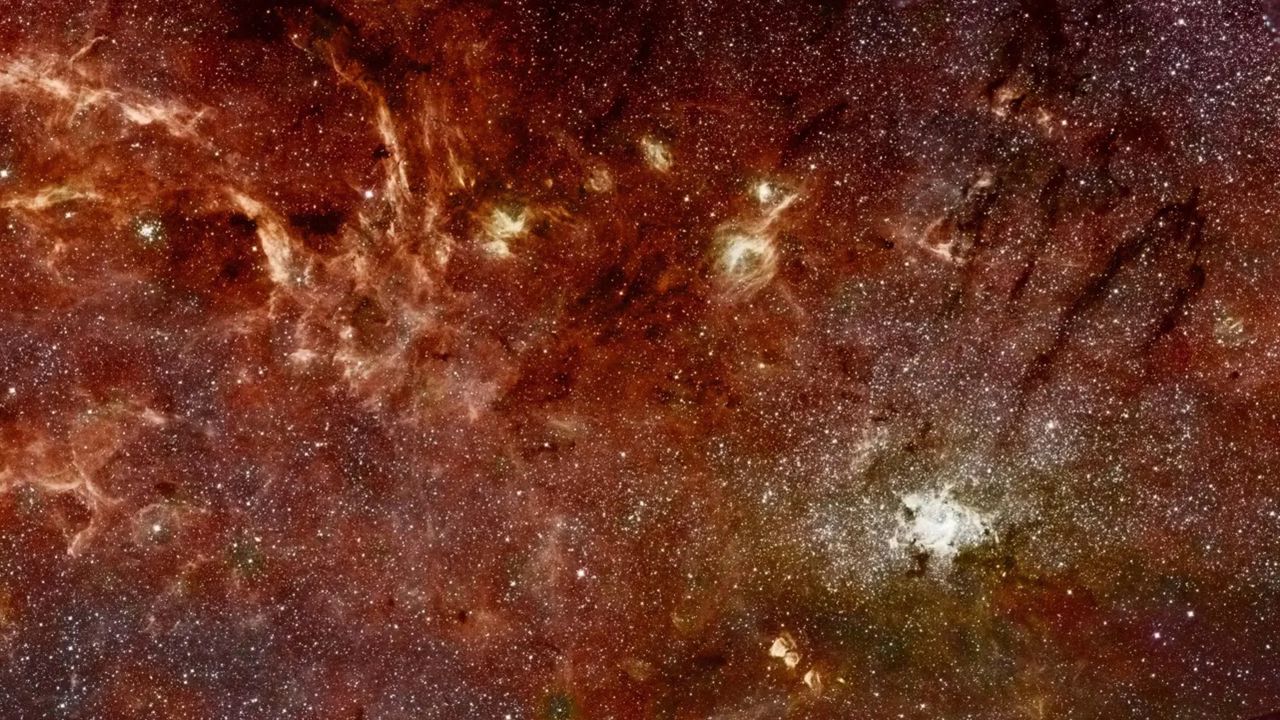Science
Scientists Uncover Potential Dark Matter Signature in Milky Way

A significant breakthrough in the quest to understand dark matter may have emerged from recent research. Scientists suggest that a faint glow emanating from the center of the Milky Way could be a vital clue in confirming the existence of this elusive material. The findings, led by Moorits Muru from the Leibniz Institute for Astrophysics Potsdam, were published on October 16, 2023, in the journal Physical Review Letters.
Dark matter, which constitutes approximately 27% of the universe’s total matter, has long perplexed scientists due to its invisibility. It neither absorbs nor reflects light, making direct detection through telescopes impossible. Despite decades of research involving underground particle detectors and space observatories, no one has yet managed to observe dark matter directly.
Recent computer simulations from Muru’s team indicate that the distribution of dark matter near the Milky Way’s center may not conform to the expected spherical shape. Instead, the research suggests it is flattened, resembling an egg. This shape aligns closely with the pattern of gamma rays detected by NASA’s Fermi Gamma-ray Space Telescope, which first identified a broad, hazy glow of high-energy light in 2008. The glow extends across approximately 7,000 light-years and is significantly brighter than existing models can account for.
The gamma-ray emissions had previously prompted various theories. Some researchers speculated that the rays were the result of collisions between invisible dark matter particles known as WIMPs (Weakly Interacting Massive Particles). Others proposed that these emissions originated from millisecond pulsars, which are rapidly spinning neutron stars that emit beams of radiation. The pulsar hypothesis gained traction due to the flattened appearance of the gamma-ray glow, which mirrored the structure of the Milky Way’s dense core.
To examine these competing theories, Muru and his team utilized powerful supercomputers to simulate the formation of the Milky Way, incorporating billions of years of galactic collisions and mergers. Their simulations revealed that these violent events left deep “fingerprints” on the distribution of dark matter within the galaxy’s core. The results indicate that when accounting for this complex history, the dark matter halo takes on a flattened shape that better matches the observed gamma-ray emissions.
Muru remarked, “We’re showing that dark matter also has this flattened shape. So, it does match the [gamma-ray] excess much better than expected before.” This finding reinforces the possibility that dark matter is indeed a strong candidate for the source of the Milky Way’s mysterious gamma-ray glow. However, the researchers caution that the pulsar theory is not completely ruled out, as both scenarios now appear “essentially indistinguishable.”
If future observations confirm that the gamma-ray excess arises from dark matter collisions, it would provide the first indirect evidence for the existence of WIMPs. More definitive answers may arrive by the late 2020s, when the Cherenkov Telescope Array Observatory (CTAO) begins its operations. The observatory, which will have sites in Chile and Spain, aims to observe gamma rays at a higher resolution than the Fermi telescope, potentially allowing scientists to differentiate between emissions from pulsars and dark matter particles.
Muru also highlighted the potential for studying gamma-ray emissions from smaller dwarf galaxies orbiting the Milky Way, which contain dense pockets of dark matter. “That’s where we hope to measure the signal,” he stated. “We’re really looking forward to these observations.”
Despite the challenges, scientists remain convinced of dark matter’s existence. The ongoing search for direct detection continues to be both a frustrating and exhilarating endeavor in modern physics. “For some reason, it still eludes us,” Muru noted. “And I think the mystery makes it even more interesting.” As research progresses, the scientific community eagerly anticipates new discoveries that could shed light on one of the universe’s most profound mysteries.
-

 Science4 weeks ago
Science4 weeks agoALMA Discovers Companion Orbiting Giant Red Star π 1 Gruis
-

 Top Stories2 months ago
Top Stories2 months agoNew ‘Star Trek: Voyager’ Game Demo Released, Players Test Limits
-

 Politics2 months ago
Politics2 months agoSEVENTEEN’s Mingyu Faces Backlash Over Alcohol Incident at Concert
-

 World2 months ago
World2 months agoGlobal Air Forces Ranked by Annual Defense Budgets in 2025
-

 World2 months ago
World2 months agoElectrification Challenges Demand Advanced Multiphysics Modeling
-

 World2 months ago
World2 months agoMass Production of F-35 Fighter Jet Drives Down Costs
-

 Business2 months ago
Business2 months agoGold Investment Surge: Top Mutual Funds and ETF Alternatives
-

 Science2 months ago
Science2 months agoTime Crystals Revolutionize Quantum Computing Potential
-

 Top Stories2 months ago
Top Stories2 months agoDirecTV to Launch AI-Driven Ads with User Likenesses in 2026
-

 Entertainment2 months ago
Entertainment2 months agoFreeport Art Gallery Transforms Waste into Creative Masterpieces
-

 Health2 months ago
Health2 months agoGavin Newsom Critiques Trump’s Health and National Guard Plans
-

 Business2 months ago
Business2 months agoUS Government Denies Coal Lease Bid, Impacting Industry Revival Efforts









